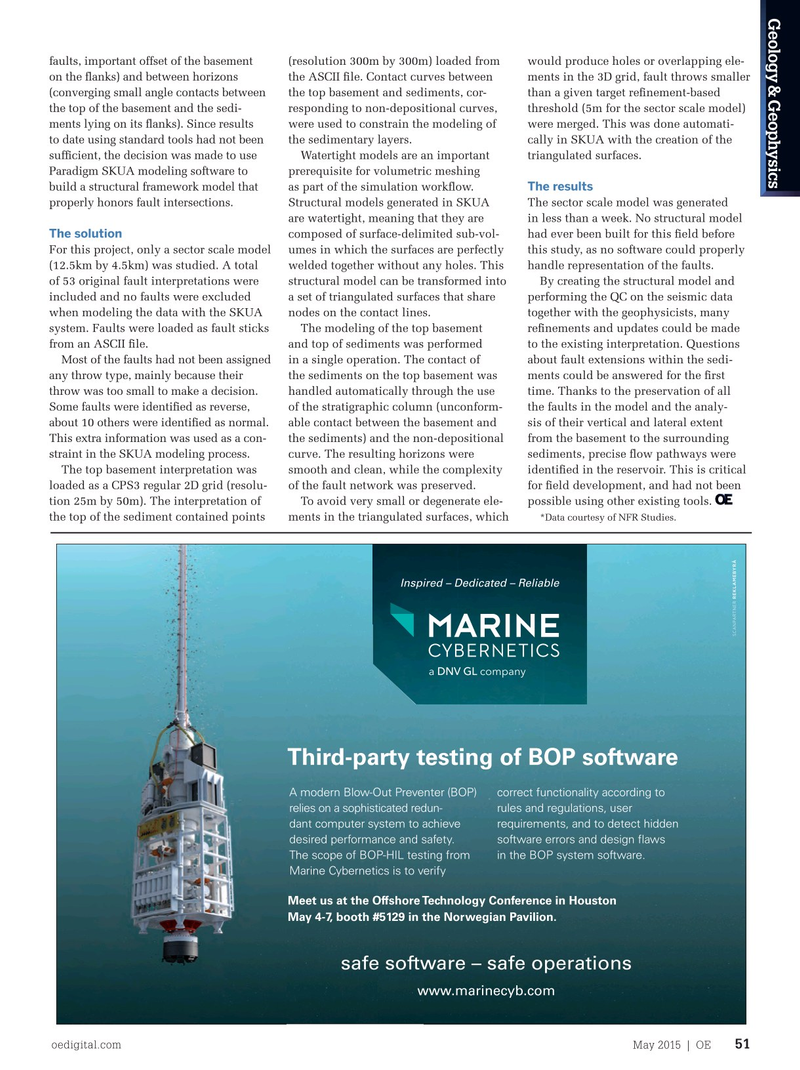
Page 49: of Offshore Engineer Magazine (May/Jun 2015)
Read this page in Pdf, Flash or Html5 edition of May/Jun 2015 Offshore Engineer Magazine
Geology & Geophysics faults, important offset of the basement (resolution 300m by 300m) loaded from would produce holes or overlapping ele- on the fanks) and between horizons the ASCII fle. Contact curves between ments in the 3D grid, fault throws smaller (converging small angle contacts between the top basement and sediments, cor- than a given target refnement-based the top of the basement and the sedi- responding to non-depositional curves, threshold (5m for the sector scale model) ments lying on its fanks). Since results were used to constrain the modeling of were merged. This was done automati- to date using standard tools had not been the sedimentary layers. cally in SKUA with the creation of the suffcient, the decision was made to use Watertight models are an important triangulated surfaces.
Paradigm SKUA modeling software to prerequisite for volumetric meshing
The results build a structural framework model that as part of the simulation workfow. properly honors fault intersections. Structural models generated in SKUA The sector scale model was generated are watertight, meaning that they are in less than a week. No structural model
The solution composed of surface-delimited sub-vol- had ever been built for this feld before
For this project, only a sector scale model umes in which the surfaces are perfectly this study, as no software could properly (12.5km by 4.5km) was studied. A total welded together without any holes. This handle representation of the faults. of 53 original fault interpretations were structural model can be transformed into By creating the structural model and included and no faults were excluded a set of triangulated surfaces that share performing the QC on the seismic data when modeling the data with the SKUA nodes on the contact lines. together with the geophysicists, many system. Faults were loaded as fault sticks The modeling of the top basement refnements and updates could be made from an ASCII fle. and top of sediments was performed to the existing interpretation. Questions
Most of the faults had not been assigned in a single operation. The contact of about fault extensions within the sedi- any throw type, mainly because their the sediments on the top basement was ments could be answered for the frst throw was too small to make a decision. handled automatically through the use time. Thanks to the preservation of all
Some faults were identifed as reverse, of the stratigraphic column (unconform- the faults in the model and the analy- about 10 others were identifed as normal. able contact between the basement and sis of their vertical and lateral extent
This extra information was used as a con- the sediments) and the non-depositional from the basement to the surrounding straint in the SKUA modeling process. curve. The resulting horizons were sediments, precise fow pathways were
The top basement interpretation was smooth and clean, while the complexity identifed in the reservoir. This is critical loaded as a CPS3 regular 2D grid (resolu- of the fault network was preserved. for feld development, and had not been tion 25m by 50m). The interpretation of To avoid very small or degenerate ele- possible using other existing tools. *Data courtesy of NFR Studies.
the top of the sediment contained points ments in the triangulated surfaces, which
Inspired – Dedicated – Reliable
SCANPARTNER REKLAMEBYRÅ a DNV GL company
Tideway provides total offshore solutions for the renewables market, the interconnector as well as the oil & gas
Third-party testing of BOP software markets. Specifcally in the feld of offshore windfarms our engineering
A modern Blow-Out Preventer (BOP) correct functionality according to services have become the cutting edge relies on a sophisticated redun- rules and regulations, user of operations.
dant computer system to achieve requirements, and to detect hidden desired performance and safety. software errors and design ? aws
The scope of BOP-HIL testing from in the BOP system software.
We engineer, we install,
Marine Cybernetics is to verify we protect.
Meet us at the Offshore Technology Conference in Houston
May 4-7, booth #5129 in the Norwegian Pavilion.
safe software – safe operations www.marinecyb.com
E [email protected] W www.deme-group.com/tideway oedigital.com May 2015 | OE 51 048_OE0515_G&G2_Paradigm.indd 51 4/19/15 11:58 PM

 48
48

 50
50